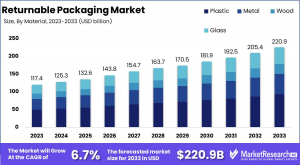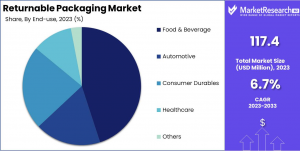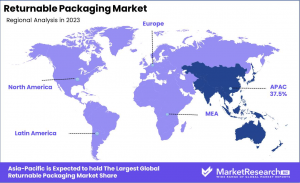Returnable Packaging Market to Reach USD 220.9 Billion by 2033, Growing at 6.7% CAGR
Global Returnable Packaging Market to Reach USD 220.9 Billion by 2033, Growing at a CAGR of 6.7% from USD 117.4 Billion in 2023
APAC holds 37.5% of the returnable packaging market, driven by the e-commerce boom, sustainability focus, and reusable packaging in logistics and manufacturing.”
NEW YORK, NY, UNITED STATES, February 2, 2025 /EINPresswire.com/ -- Market Overview— Tajammul Pangarkar
The Global Returnable Packaging Market was valued at USD 117.4 Bn in 2023. It is expected to reach USD 220.9 Bn by 2033, with a CAGR of 6.7% during the forecast period from 2024 to 2033.
The Returnable Packaging Market refers to the industry focused on designing, manufacturing, and supplying reusable packaging solutions such as containers, pallets, crates, and drums. These solutions are designed for multiple trips and extended lifespans, offering a sustainable alternative to single-use packaging.
Primarily used in industries like automotive, food and beverage, retail, and logistics, returnable packaging reduces waste, lowers costs, and enhances supply chain efficiency. Its growing adoption is driven by the need for eco-friendly practices and operational cost savings.
The Returnable Packaging Market is poised for steady growth, fueled by increasing awareness of sustainability and the circular economy. Businesses across industries are transitioning from single-use to reusable packaging to minimize environmental impact and comply with stringent regulations. Governments worldwide are actively promoting sustainable practices through investments in green initiatives and policies that encourage waste reduction.
For instance, regulations limiting plastic usage and mandating recycling targets are pushing companies to adopt returnable packaging solutions. Additionally, public and private sector collaborations are fostering innovation in materials and design, further propelling market expansion. These factors, combined with the rising demand for efficient supply chain solutions, create a robust growth trajectory for the returnable packaging industry.
The Returnable Packaging Market presents significant opportunities for both new entrants and established players. For existing businesses, diversifying product portfolios to include customizable and industry-specific solutions can strengthen market positioning. Investing in R&D to develop lightweight, durable, and cost-effective materials will also enhance competitiveness.
New players can capitalize on the growing demand by offering innovative, sustainable packaging solutions tailored to niche markets. Partnerships with logistics and manufacturing companies can further drive business growth. Additionally, leveraging digital technologies to optimize tracking and management of returnable assets can provide a competitive edge. Overall, the market’s emphasis on sustainability and efficiency offers ample scope for expansion and innovation.
Curious About Market Trends? Request Your Complimentary Sample Report Today: https://marketresearch.biz/report/returnable-packaging-market/request-sample/
Key Takeaway
-- Market Growth: The Global Returnable Packaging Market was valued at USD 117.4 Bn in 2023. It is expected to reach USD 220.9 Bn by 2033, with a CAGR of 6.7% during the forecast period from 2024 to 2033.
--By Product Type: Intermediate Bulk Containers (IBCs) dominate the Returnable Packaging Market with a commanding market share of 34%.
--By Material: Plastic stands out as the leading material in the Returnable Packaging Market, capturing 42% of the market share, making it a preferred choice for manufacturers and end-users alike.
--By End-use: The Food & Beverage sector is the predominant end-user in the Returnable Packaging Market, holding a substantial 45% market share, to ensure product safety and reduce environmental impact.
--Regional Dominance: Asia Pacific holds a commanding 37.5% share in the Returnable Packaging Market, reflecting strong regional adoption and market growth.
Use Cases
Automotive Industry: The automotive sector uses returnable packaging for transporting parts like engines, tires, and batteries. These durable containers reduce waste, lower costs, and improve supply chain efficiency.
Retail and E-commerce: Returnable packaging is gaining traction in retail and e-commerce for shipping products like electronics, clothing, and groceries. It reduces single-use packaging waste and aligns with sustainability goals.
Food and Beverage Industry: Returnable crates, trays, and containers are used for transporting fresh produce, dairy products, and beverages. They ensure product safety, reduce spoilage, and support eco-friendly practices.
Pharmaceuticals: The pharmaceutical industry uses returnable packaging for transporting medicines and medical devices. These containers are designed to meet strict hygiene and safety standards while reducing packaging waste.
Manufacturing and Logistics: Returnable packaging is widely used in manufacturing and logistics for transporting raw materials, components, and finished goods. It enhances supply chain efficiency, reduces costs, and minimizes environmental impact.
Driving Factors
Supply Chain Cost Reduction: Companies are finding that returnable packaging reduces long-term shipping costs. The initial investment is offset by reduced packaging waste and lower ongoing material expenses.
Environmental Regulations: Government policies promoting circular economy principles favor returnable packaging systems. Companies can meet sustainability targets and comply with packaging waste regulations.
Technology Integration: Smart tracking systems make returnable packaging more manageable and efficient. RFID tags and IoT sensors help companies monitor their packaging assets and optimize return logistics.
Industrial Automation: Automated handling systems work better with standardized returnable containers. This drives adoption in manufacturing and warehouse operations.
Quality Protection: Durable returnable packaging often provides better product protection than disposable options. This is especially valuable for sensitive industrial components and automotive parts.
Report Segmentation
By Product Type
• Pallets
• Bottles
• Crates
• Dunnage
• Drums & Barrel
• Intermediate Bulk Containers (IBCs)
• Others
By Material
• Plastic
• Metal
• Wood
• Glass
By End-use
• Food & Beverage
• Automotive
• Consumer Durables
• Healthcare
• Others
Ready to Act on Market Opportunities? Buy Your Report Now and Get 30% off: https://marketresearch.biz/purchase-report/?report_id=48063
Regional Analysis
Asia Pacific holds a commanding 37.5% share in the returnable packaging market, reflecting strong regional adoption driven by the growth of e-commerce, manufacturing, and logistics sectors. Returnable packaging solutions—such as reusable crates, pallets, and containers—are increasingly favored for their cost-effectiveness and sustainability benefits. The rise of supply chain optimization and a growing focus on reducing packaging waste have made returnable packaging an attractive alternative to single-use options.
Industries like automotive, food and beverage, and retail, which rely heavily on packaging for bulk goods transportation, are particularly adopting these systems to enhance efficiency and reduce environmental impact. Governments in several APAC countries are pushing for more sustainable practices, which is encouraging the shift toward reusable packaging solutions.
Additionally, the region’s extensive logistics networks and the rise of cross-border trade have contributed to the widespread use of returnable packaging for long-distance transportation. As sustainability becomes a critical focus for businesses and consumers alike, the returnable packaging market in Asia Pacific is expected to continue to grow, driven by both environmental concerns and cost-saving incentives.
Growth Opportunities
Cost Savings: Returnable packaging offers significant cost savings over time by reducing the need for single-use packaging materials. Companies can highlight these economic benefits to attract cost-conscious clients.
Sustainability Initiatives: The push for sustainability is driving demand for returnable packaging solutions. Companies can focus on developing durable and reusable packaging that minimizes waste and environmental impact.
Supply Chain Efficiency: Returnable packaging can enhance supply chain efficiency by reducing the need for frequent packaging replacements and streamlining logistics. Companies can offer solutions that integrate seamlessly into existing supply chains.
Customization and Flexibility: Offering customizable returnable packaging solutions that cater to specific industry needs can attract a broader customer base. Companies can provide packaging tailored to different product types and transportation requirements.
Technological Integration: Incorporating advanced technologies, such as RFID tracking and IoT-enabled monitoring, can improve the management and tracking of returnable packaging. Companies can offer smart packaging solutions that enhance visibility and control.
Key Players
• Amatech, Inc.
• Schoeller Allibert
• ORBIS Corporation
• RPR Inc.
• Tri-pack Packaging Systems Ltd.
• NEFAB GROUP
• IPL, Inc.
• RPP Containers
• UBEECO Packaging Solutions
• CHEP
• PPS Midlands Limited
• Celina
• Brambles
Not Sure? Request a Sample Report and See How Our Insights Can Drive Your Business: https://marketresearch.biz/report/returnable-packaging-market/request-sample/
Conclusion
In conclusion, the markets analyzed are all experiencing growth driven by evolving consumer preferences, technological advancements, and increasing demand for customized, high-quality products. Key trends, such as the adoption of sustainable practices, integration of smart technologies, and rising disposable incomes, are shaping the competitive landscape. While challenges such as market saturation, price sensitivity, and regional differences persist, opportunities abound for companies to capitalize on niche segments, leverage digital platforms, and innovate to meet the specific needs of their target audiences. As these industries continue to expand, businesses that adapt to changing trends, prioritize customer-centric strategies, and invest in innovation will be well-positioned for long-term success.
Related Report
Polystyrene Packaging Market: https://marketresearch.biz/report/polystyrene-packaging-market/
Paper Packaging Material Market: https://marketresearch.biz/report/paper-packaging-material-market/
Printed Cartons Market: https://marketresearch.biz/report/printed-cartons-market/
Molded Pulp Packaging Market: https://marketresearch.biz/report/molded-pulp-packaging-market/
Polyhydroxybutyrate Market: https://marketresearch.biz/report/polyhydroxybutyrate-market/
Global Tobacco Market: https://marketresearch.biz/report/global-tobacco-market/
Lawrence John
Prudour
+91 91308 55334
Lawrence@prudour.com
Legal Disclaimer:
EIN Presswire provides this news content "as is" without warranty of any kind. We do not accept any responsibility or liability for the accuracy, content, images, videos, licenses, completeness, legality, or reliability of the information contained in this article. If you have any complaints or copyright issues related to this article, kindly contact the author above.



